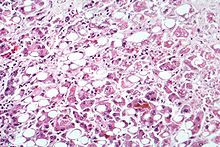| Alcoholic liver disease | |
|---|---|
| Other names | Alcohol-related liver disease |
 | |
| Microscopy of liver showing fatty change, cell necrosis, Mallory bodies | |
| Specialty | Gastroenterology |
Alcoholic liver disease (ALD), also called alcohol-related liver disease (ARLD), is a term that encompasses the liver manifestations of alcohol overconsumption, including fatty liver, alcoholic hepatitis, and chronic hepatitis with liver fibrosis or cirrhosis.[1]
It is the major cause of liver disease in Western countries, and is the leading cause of death from excessive drinking.[2][3] Although steatosis (fatty liver disease) will develop in any individual who consumes a large quantity of alcoholic beverages over a long period of time, this process is transient and reversible.[1] More than 90% of all heavy drinkers develop fatty liver whilst about 25% develop the more severe alcoholic hepatitis, and 15% liver cirrhosis.[4]
For patients with chronic hepatitis B, a strict adherence to abstinence is highly recommended.[5]
- ^ a b O'Shea RS, Dasarathy S, McCullough AJ (January 2010). "Alcoholic liver disease: AASLD Practice Guidelines" (PDF). Hepatology. 51 (1): 307–28. doi:10.1002/hep.23258. PMID 20034030. S2CID 41729364. Archived from the original (PDF) on 21 October 2014. Retrieved 18 October 2011.
- ^ Smith, Dana G. (4 March 2024). "The Top Cause of Alcohol-Related Deaths Can Go Undetected for Years". The New York Times. ISSN 0362-4331. Retrieved 6 March 2024.
- ^ "ARDI Alcohol-Attributable Deaths, US | CDC". nccd.cdc.gov. Retrieved 6 March 2024.
- ^ Basra, Sarpreet (2011). "Definition, epidemiology and magnitude of alcoholic hepatitis". World Journal of Hepatology. 3 (5): 108–113. doi:10.4254/wjh.v3.i5.108. PMC 3124876. PMID 21731902.
- ^ Iida-Ueno, A; Enomoto, M; Tamori, A; Kawada, N (21 April 2017). "Hepatitis B virus infection and alcohol consumption". World Journal of Gastroenterology. 23 (15): 2651–2659. doi:10.3748/wjg.v23.i15.2651. PMC 5403744. PMID 28487602.